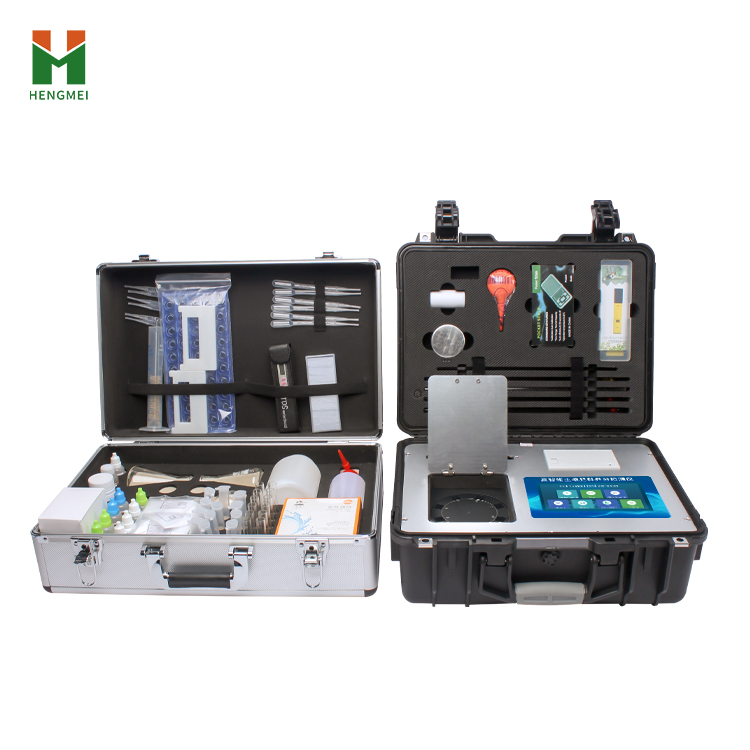With the advancement of agricultural modernization, the traditional "experience fertilization" model can no longer meet the needs of modern agricultural development. As the core equipment of precision agriculture, the soil NPK analyzer scientifically measures soil nutrient content and provides personalized fertilization plans for users based on crop demand characteristics, realizing the scientific fertilization concept of "supplementing what is lacking and what is lacking".
The soil NPK analyzer integrates medicine, equipment, and instruments, equivalent to a small mobile laboratory, which can quickly detect available nitrogen, phosphorus, potassium, and various trace elements in soil. This instrument adopts advanced spectral analysis technology and intelligent data processing system, with high detection accuracy and easy operation. It is very suitable for users such as agricultural service departments, agricultural material distributors, and large-scale growers to conduct on-site rapid detection and fertilization guidance.

Working principle and technical characteristics of soil NPK analyzer
1.1 Core detection principle
The soil NPK analyzer mainly uses spectrophotometry for soil nutrient detection, and its working principle can be divided into three key steps:
Sample pre-treatment:
Soil samples are treated with specific leaching agents to transfer available nutrients from the solid phase to the liquid phase of the soil
Different nutrients are extracted using different extraction methods:
Quick acting nitrogen: extraction with potassium chloride solution
Effective phosphorus: extraction with sodium bicarbonate or ammonium fluoride hydrochloric acid solution
Quick acting potassium: ammonium acetate solution extraction
Color reaction:
The target nutrients in the extraction solution react with specific colorimetric reagents to generate colored compounds
Typical reactions include:
Ammonium nitrogen reacts with sodium salicylate to form blue compounds under alkaline conditions
Phosphorus reacts with ammonium molybdate to form phosphomolybdic blue
Potassium and sodium tetraphenylborate form a white precipitate (determined by turbidity method)
Optical inspection:
Using a 4-wavelength professional testing cold light source (red, blue, green, orange)
Measure the absorbance of the colorimetric solution using a standard 1cm cuvette
Calculate nutrient content based on Lambert Beer law
Dual row design with 12 detection channels, capable of detecting multiple samples simultaneously
1.2 Analysis of Instrument Technical Parameters
The soil NPK analyzer has the following core performance indicators:
Detection accuracy: nitrogen, phosphorus, and potassium error ≤ 1%, organic matter error ≤ 2%, ensuring the accuracy of the fertilization plan
Detection efficiency: 20 minutes for a single soil sample (NPK), 8 soil samples ≤ 1 hour, meeting the needs of rapid field detection
Detection channel: Dual row 12 channels, significantly improving detection throughput
Light source system: 4-wavelength cold light source with a lifespan of 100000 hours, ensuring long-term stability
Data management: Supports WiFi/4G/GPRS transmission for easy data sharing and analysis
Power system: AC/DC dual-use, 10 hour battery life, suitable for outdoor working environment
1.3 Instrument Structure and Functional Characteristics
The modern soil NPK analyzer has multiple innovations in hardware and software design:
Intelligent detection system: ARM Cortex-A7 quad core processor, with a main frequency of 1.88GHz; 12 channel simultaneous detection design; Built in calibration function, automatic light intensity calibration
Expert decision-making system: fertilization models for over a hundred crops; Plant nutrition diagnostic map; Personalized fertilization plan generation
Data management system: Smart Cloud Agriculture Platform; Multi way data export (USB/Ethernet/USB drive); Mobile data viewing
User friendly design: 7-inch true color touch screen; Operation guidance video; High strength portable design
Extended functions: GPS positioning recording; Multi account management; Switching between Chinese and English interfaces
Technical advantages and application value of soil testing and formula fertilizer applicator
2.1 Analysis of Technical Advantages
Compared with traditional fertilization methods, the soil NPK analyzer has significant advantages:
Precision fertilization: A 1% detection error ensures the accuracy of the fertilization plan, resulting in a 28% increase in fertilizer utilization rate in a certain wheat planting area.
Efficient detection: The 12 channel design has increased detection efficiency by 5 times, and the daily detection volume of a certain agricultural service center has increased from 20 to 100.
Scientific decision-making: The built-in expert system provides personalized solutions, resulting in a 35% reduction in fertilizer costs and a 22% increase in yield in a certain orchard.
Data Intelligence: Cloud based data management supports long-term analysis, and a certain farm has established a soil nutrient change database to guide crop rotation.
Economic and environmental protection: Precise fertilization reduces excessive use of chemical fertilizers. After promoting it in a certain county, the annual reduction of chemical fertilizer input is 8000 tons.
2.2 Application Value Reflection
The soil testing and formula fertilizer applicator plays an important role in various aspects of agricultural production:
Field crops: precision fertilization of staple crops such as wheat and corn; A certain base achieved a 15% increase in production and a 20% reduction in fertilizer
Economic crops: efficient cultivation of fruit trees, vegetables, and other crops; The quality of a certain vineyard has been improved, and the selling price has increased by 30%
Soil improvement: acidification and salinization soil treatment; The soil pH value in a certain area has increased by 0.5 in three years
Fertilizer production: research and validation of formula fertilizers; The adaptability of a certain enterprise's product has increased by 40%
Agricultural services: agricultural technology promotion and training; The service area of a certain cooperative has expanded threefold
Industry pain points and solutions for soil testing and formula fertilization equipment
3.1 Challenges Faced by Fertilization Management
Experience dependence: Traditional fertilization relies on experience and has a high degree of blindness. A survey in a certain region shows that 70% of farmers have excessive fertilization.
Detection lag: The laboratory testing cycle is long (3-5 days), making it difficult to guide field fertilization in a timely manner.
Technical complexity: The threshold for soil testing formula technology is high, and it is difficult to promote at the grassroots level.
Data missing: Lack of systematic soil database, making it difficult to conduct long-term analysis.
Cost pressure: The price of fertilizers has risen, and there is an urgent need to improve utilization efficiency.
3.2 Solution for Soil Testing and Formula Fertilization Instrument
Precision fertilization plan: rapid detection (20 minutes/sample); Intelligent algorithm recommends fertilizer application amount; 12 channel batch testing
Technical service plan: operation video guidance; Expert remote support; Mobile applications
Data management solution: cloud based data storage; Historical change analysis; visualization display
Cost control plan: reduce fertilizer waste; Optimize the frequency of fertilization; Increase crop yield
Talent cultivation plan: Simplify operational procedures; On site training guidance; Continuous technical support
Article address:https://www.soiltesting.cn/news1/125.html






